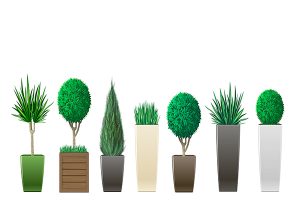Harsh winter weather can be a threat to a container garden. Freezing temperatures can cause damage to both plants and their containers, whilst heavy winter rain can put soil at risk of becoming waterlogged. But by preparing your containers for the cold and rainy season, you can prevent disasters and ensure your plants are in good condition come spring time. So take a read of our top tips for your container garden before the cold weather hits!
Wooden pots and planters are the best choice for winter gardens
Just like plants, not all pots and containers are strong enough to survive once the frost has hit, so it’s important to consider the quality of the planter you use. Some materials are prone to break in the winter so you will find yourself constantly replacing the containers over time. Porous materials like terracotta, stone and ceramic are highly likely to crack during winter as they absorb water which expands when frozen.
In comparison, a non-porous material like timber does extremely well when exposed to cold temperatures. This makes strong wooden containers an ideal choice for a winter container garden. Unlike clay pots, wood planters are highly durable and can be treated to help prevent rot. Hardwood planters in particular stand well against the elements and can provide your plants with the protection they need. It is recommended that your winter plants are two zones lower in cold hardiness than the container hardiness for the best results.
A large container offers more insulation
The size of your planter is just as important as the material it is made from when it comes to preparing your containers for the winter. Small pots will freeze much faster and dry out more than larger pots will, so a large wooden planter is a better choice for your plants. The large volume means more soil can be used in the pot, which greatly improves insulation for the plant’s roots.
Avoid exposing plants to fluctuating temperatures
The roots of plants are vulnerable to frost so it’s important to prepare your planters so that they are not exposed to a freeze and thaw cycle that will kill your plants. If your planters are currently placed on pavement, you should move these to be positioned on soil instead so that they are less affected by changes in temperature. The sun can easily increase the temperature of pavement which in turn elevates the heat your plants are exposed to. However, in the winter the temperature at night drops significantly, meaning a process of freezing and thawing can occur.
Drainage is vital for plant health
A container with drainage holes is important for plants at any time of year, and particularly vital if your plants are going to survive during the cold and rainy season. Container gardens are vulnerable to waterlogging which can kill most potted plants, so your plant container must include drainage holes. Without them, rain water will be unable to drain fast enough and the soil will become saturated. This leaves no air space in the soil and your plants will drown. This also means you have to consider how much you will water your plants over the winter months. In general, you should only water them when the soil is unfrozen and dry. Then when the temperatures start to plummet and your planter freezes, you should no longer be watering your plants to reduce the risk of waterlogging.
Group your planters together for extra protection
If you have a number of containers in your garden, you can further protect them from the wet and cold by moving them close together. This grouping of containers can improve the volume of insulation and create a barrier against harsh winds during the winter. Place the hardiest plants on the outside and the least hardy plants in the centre so the most vulnerable plants have added protection. Where possible, you should move your planters to a sheltered location, such as against a wall or under an eave, or build a windbreak around your containers so that they’re not open to strong gales and downpours.
For more advice about your planter or to order a bespoke wooden container, speak to Taylor Made Planters today!
Published: 23rd October 2017





















